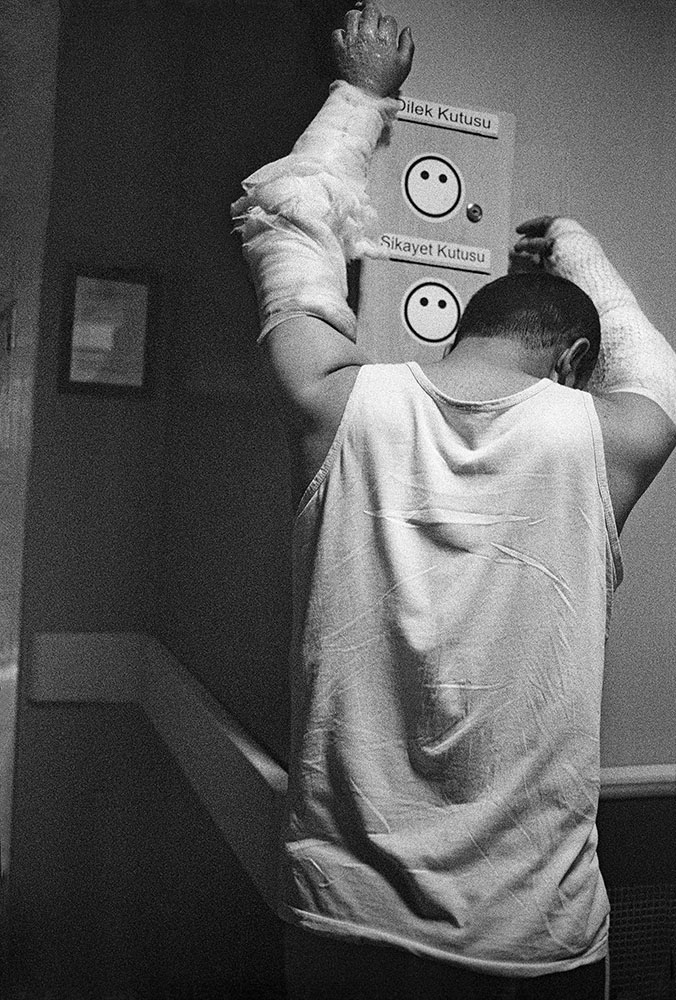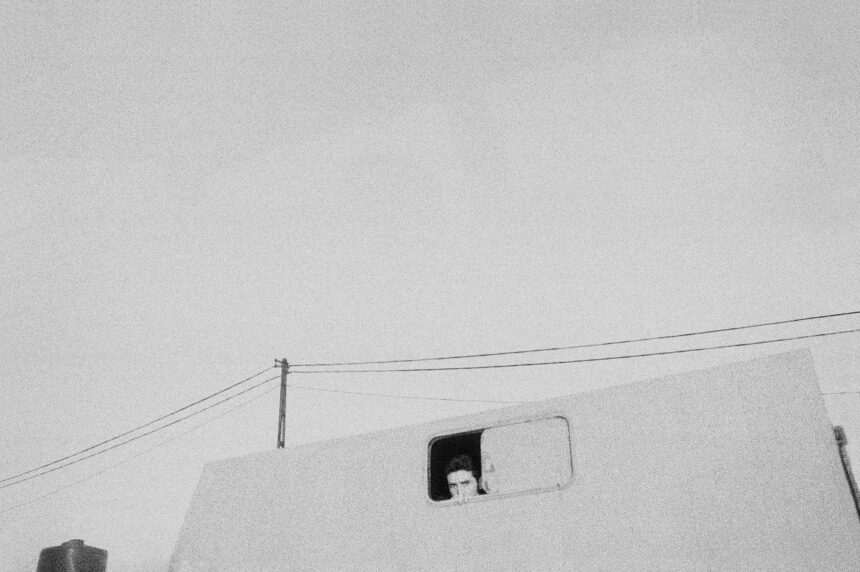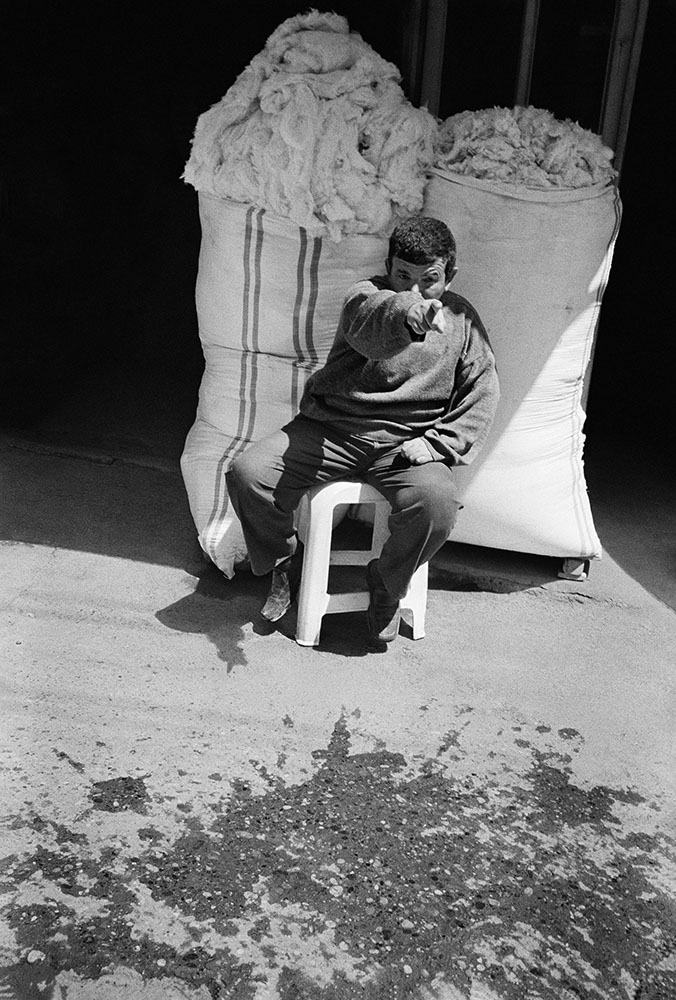ALP SİME // LAKİ
Being isolated from everything has led us to question our lives as well. On the other hand “Laki” is you, like others, in this exhibition, isn’t it?
The photographer might be more at the forefront in some images. We can say these photographs are the ones that question the witness more.
The old man from my work named “Friend” next to “The Tattooed Girl” and my deceased father were in the same class in elementary school. He has a face which is intolerant of injustice. To me a face is not only genetics, it is like handwriting. It is formed afterwards.
What about those with poker faces? Do they constantly hide something?
I don’t think so. I am not sure but facial muscles must be developing while we are asleep. Maybe they are taking form out of our control.
Can you say, looking inwards, that “Laki” is more intolerant?
No, but I can’t read some things, at some point they are starting to get blurry. After the pieces are hung, I look at them with a different eye. When you use images of people, unavoidably, you make them question themselves and then you start to question yourself, I guess it’s for equality… Is that why it appears to be intolerant?
Maybe. You don’t ask for permission before you take their photographs, do you?
I don’t ask for permission. Because then they wouldn’t look like the “thing” I want.
What about the piece next to it? The piece called “Tattooed Girl”, is it from Turkey as well?
Aside from “OJ Simpson” all of them are from Turkey. I asked why she had got such a tattoo; she had said that she liked “Swastika” as a shape.
How much of your works are affected by the spirit of the past?
If you mean the fact that they are black and white, it isn’t a fully developed method, it is still evolving. The pictorial language in the photographs is still evolving as well.
You said pictorial language. Why not photographic or visual language?
They add up to the same thing but the definition of pictorial language is wider. And photographic language doesn’t provide what I am asking for. In the first hand growing years of photography, it actually had nothing to do with photography. In fact, during the first years, especially in terms of aesthetics, it didn’t contribute to itself at all. Nowadays, I think it is still limited.
Doesn’t the fact that this medium progresses over a pre-agreement make it a different language? In photography, the fact as if you are/were there is more in the foreground. Photographs have an impact to make you say, “Someone was there and witnessed this image.” by its’ reliving effect, whether it is fictional or real. Don’t you think this makes it a different language?
It sure is more capable of transferring some things but the language is the same language. Photography has a deceiving feature. It cuts across the neural system. But the concept of the reliving effect that you mentioned exists in any medium related to the figure itself.
I don’t think being competent makes it a different language. There used to be an evidence-like feature that makes the photography different, but it looks like it came to end as well.
These kinds of dialogues are mostly made for positive publicity. But you tend to do the opposite. Why am I the one who is defending the photography?
Of course, I am not despising, I am only trying to understand. The time that we are passing through is to look over. Photography, in general, is a discipline which is questioning and invites others to do the same. Then why is it not inquirable itself? I am questioning myself and others, then why not question what stands in the middle? For me, it doesn’t have untouchability.
I notice that you are questioning the capacity of the photographic medium in the works that are exhibited as groups.
Actually, it isn’t the same thing. They have a mocking attitude.
Why did you want to mock with that?
So that the process doesn’t take me under its control. Remind me what I am doing is not for a purpose or responsibility. Taking photographs, and selecting and processing them are very different processes. During the editing phase, you are losing touch with reality and feel as if you are saving the world.
At this stage, there are a lot of baits to make you think that they’re all parts of a bigger story. You get the impression that you are doing a service when there is no such a thing. Those games are exactly there as reminders. I don’t like to repeat, but I’m sure that I and lots of other photographers are thinking that we are writing novels when we are working. When it comes to an end, we are adapting short story rules to this situation. Like the format used in popular cinema, where every element is important and supports one another. It works but is not enough. And when I see that it is not sufficient, not to get crazy, I am walking up to this game.
It can’t tell a story from beginning to end.
Yes. Photography is outstanding at asking questions and triggering the imagination of the audience. What makes photography so special, I can define like this: “You are murmuring in your sleep and somebody understands what you mean.”
Some photographs need an explanation. For example, your work is called “Mete.”
Actually, it doesn’t really need an explanation. I just like to talk about it.
The person in this photograph is your uncle.
Yes.
Did you take this photograph?
I couldn’t have taken it; I was too young the year it was taken.
Why did you include it in your exhibition?
I wanted to see it standing next to my other works. Because it is as if this photograph fills a missing place in my head.
He was deaf and speech impaired, was a photographer, and passed away at a young age from a rare disease. Do you think you are a photographer because of your uncle?
I definitely believe he had a strong impact. Now I understand better, how traumas are directing us. Probably if there wasn’t for the longing my family felt for him, they wouldn’t let me become a photographer.
Trauma is an important constituent of “Laki”, right? Why did you pick the name “Laki”, which means “Moral Police” in the Lubunca language?
Lubunca is a language born out of oppression, danger and the need for hiding. The images in the exhibition are revolving around these concepts but those who are using this language are included in the exhibition indirectly. Precisely, they are compelled to hide, they should not be seen and heard.
Do you see this exhibition as a part of the LGBTIQ+ movement?
LGBTIQ + and especially trans people are long-standing victims of the culture of shame, I am honoured to use this word for the exhibition. There is no comprehensive and explanatory aspect of “Laki”. To me, the LGBTIQ + movement represents much more than itself. “Laki” reminds me that all “others”, including myself, might have much bigger difficulties in the future. I am also aware that this exhibition will not raise any awareness.
I am aware that you want the photographs which have balls in them to evoke an association with homophobic swearing. Are you worried about being misunderstood?
I have no such worries. I want to draw attention to what swearing is and for what purpose it is used. Swearing serves to keep people away from each other. The wounds caused by these words also break apart societies. This is far greater than the damage they cause on a personal level. A society that associates many things about sexuality with shame may not look at theft or murder in a similar way. This is very interesting to me, as it is to many people. You can develop a personal consciousness in what is called the guilt culture.
The concept of the wrong and the right concerns you more, then you can say “Why do you care about my life?”. In cultures of shame, the question “What will others say?” is more in the foreground. I do not want to be concerned with what others will say. I am also someone caught between the culture of shame and the culture of guilt. I often confuse guilt and shame. I can’t comprehend that they’re different. I was raised like this through my education and my family.
What about the culture of fear, the thoughts of what will happen to me?
I’m not there yet mentally. I don’t think it has taken over my whole personality yet. My mind sometimes tells me that I should be afraid, but I guess it hasn’t touched me so deeply yet. I do not feel the traces of the culture of fear in others as well. If we can’t put up a fight against being ashamed, I’m sure we’ll go there all together.
What do you think about “shame” itself?
I think, whatever it is, it exists to survive and adapt. All of our senses and instincts are for survival. But we are complex creatures in need of self-understanding. Analyzing and understanding are also taking a part in our fight for staying alive. We need to see and understand, what it is, the feeling of guilt and shame that we transfer to other people. It’s important to know what embarrassing or guilty things are and how they come to the life. This is a tiring job. To be able to observe yourself, to stop yourself, to try not to spread it around even if you cannot stop it… It is important for institutions, that claim to work not only on personal levels but also for the interest of others, to inspect themselves.
ALP SİME // LAKİ 01.12.20 – 16.01.21
Her şeyden izole olunca kendi hayatlarımızı da sorgular olduk. “Laki” diğerleri gibi bir yandan da sensin bu sergide değil mi?
Bazı görüntülerde fotoğrafçı daha ön planda olabilir. Tanık olanın daha çok sorgulandığı fotoğraflar da diyebiliriz .
İlkokulda, “Dövmeli Kız”ın yanındaki “Arkadaş” isimli işimdeki yaşlı adamla, rahmetli babam aynı sınıfta okumuşlar. Haksızlığa tahammül edemeyen bir yüzü var. Sadece genetik değildir yüz, el yazısı gibi bir şeydir bana göre. Sonradan şekilleniyor.
Peki poker yüzlü insanlar? Bir şeyler mi saklıyorlar sürekli?
Sanmıyorum. Emin değilim ama yüz kasları uykudayken de gelişiyor olmalı. Kontrolümüz altında değilken oluşuyorlar belki.
“Laki” için içe doğru daha tahammülsüz bakıyor diyebilir misin?
Hayır, ama bazı şeyleri okuyamıyorum, bir yerden sonra bulanıklaşmaya başlıyor. İşler asıldıktan sonra o gözle bir bakarım. İnsanların görüntülerini kullandığında onlara ister istemez kendilerini sorgulatıyorsun, sonra kendini de sorgulamaya başlıyorsun, herhalde bir eşitlik olsun diye… Ondan mı tahammülsüz duruyor?
Belki de. İzin almıyorsun değil mi çekmeden önce?
İzin almıyorum. Çünkü o zaman benim istediğim ‘şey’e benzemezler.
Peki onun yanındaki? “Dövmeli kız” isimli iş, o da Türkiye’den mi?
“OJ Simpson” hariç hepsi Türkiye’den. Neden böyle bir dövme yaptırdığını sordum; “Swas tika”yı şekil olarak beğeniyorum demişti.
İşlerinin ne kadarı geçmişin ruhundan destek alıyor?
Siyah beyaz olmalarını kastediyorsan eğer, siyah beyaz yaşını almış bir yöntem değil, hala olgunlaşıyor. Fotoğraftaki resim dili de hala gelişiyor.
Resim dili dedin. Neden fotoğraf değil ya da görsel dil değil?
Aynı kapıya çıkıyor ama görsel dilin tanımı çok daha geniş. Fotoğraf dili de tam karşılamı yor. Fotoğrafın başladığı ve olgunlaştığı zamanların aslında fotoğrafla bir ilgisi yok. Hatta ilk başladığı zamanlarda özellikle estetik açıdan kendine bir katkısı olmamış, şimdilerde ise limitli olduğunu düşünüyorum.
Bir ön anlaşma üzerinden gitmesi bu mecrayı farklı bir dil kılmıyor mu? Fotoğrafta oradaymış / oradaymışsın olgusu ön planda. Tekrar yaşatma etkisi, kurgu veya ger çek olsun, “birisi oradaydı ve bu görüntüye şahit oldu” dedirtmek gibi bir özelliği var fotoğrafların. Bu onu ayrı bir dil yapmıyor mu sence?
Bazı şeyleri aktarmada daha kabiliyetli kılıyor tabii ama dil yine aynı dil. Aldatabilen bir özelliği var fotoğrafın. Sinir sistemine kısa yoldan ulaşıyor. Ama bahsettiğin tekrar yaşatma olgusu, figüre dair herhangi bir ortamda da var. O tarafta yetkin olması onu başka bir dil yapmıyor bence. Fotoğrafı farklı kılan kanıt özelliği vardı ama o da bitiyor sanki.
Bu tür konuşmalar genelde pozitif tanıtım amaçlı olur. Sen tersine gidiyor gibisin. Niye fotoğrafı savunan benim?
Ben elbette aşağılamıyorum, sadece anlamaya çalışıyorum. İçinden geçtiğimiz zamanlar gözden geçirme zamanları… Fotoğraf genelde sorgulayan sorgulatan bir disiplin. Neden o da sorgulanmasın? Kendimi, başkalarını sorguluyorum, aradaki şeyi neden sorgulamayayım? Fotoğrafın benim için bir dokunulmazlığı yok.
Aslında gruplar halinde sergilenen işlerde fotoğraf ortamının kapasitesini sorguladığını görüyorum sanki?
Aynı şey değil aslında. Onların dalga geçer bir tavırları var.
Neden dalga geçmek istedin bununla?
İşlem beni kontrolü altına almasın diye. Yaptığım şeyin sorumluluk ya da görev amaçlı olmadığını kendime hatırlatmak için. Fotoğraf çekmek ile onları seçmek, işlemek çok farklı uğraşlar. Düzenleme aşamasında gerçeklerden kopuyorsun ve dünyayı kurtarıyor gibi hissediyorsun.
Hepsinin bir büyük hikayenin parçaları olduğunu düşündürtecek bir sürü tuzak var o aşa mada. Bir hizmette bulunuyormuş hissine kapılıyorsun, halbuki yok öyle bir şey. Tam olarak bunu hatırlatmaya yarıyor o oyunlar. Tekrar etmek hoşuma gitmiyor ama ben ve emi nim birçok diğer fotoğrafçı çalışırken roman yazdığımızı düşünüyoruz. Sonuna gelince ise kısa hikaye kurallarını bu duruma adapte ediyoruz. Her unsurun önemli ve birbirini destekler halde olduğu popüler sinemada kullanılan format gibi. İşe yarıyor ama yeterli olmuyor. Yeterli olmadığını görünce de delirmemek için oyuna sığınıyorum.
Bir hikayeyi başından sonuna anlatamıyor.
Evet. Fotoğraf soru sormakta ve seyircinin hayal gücünü tetiklemekte çok başaralı. Onu özel kılan şeyi ise şöyle tanımlayabilirim: “sen uykunda mırıldanıyorsun ve birileri ne dediğini anlıyor”.
Bazı fotoğraflarının açıklanmaya ihtiyacı var. “Mete” isimli işin mesela.
Açıklanmaya ihtiyacı yok aslında. Ben ondan bahsetmeyi seviyorum.
Bu fotoğraftaki insan, dayın.
Evet
Bu fotoğrafı sen mi çektin?
Ben çekmiş olamam, çekildiği yıl çok küçüktüm.
Neden sergine dahil ettin?
Diğer işlerin yanında görmek istiyorum onu. Çünkü bu fotoğraf kafamda sanki eksik kalmış bir şeyleri yerine oturtuyor.
Duyma ve konuşma engelliydi, fotoğrafçıydı ve genç yaşta çok nadir rastlanan bir hastalıktan vefat etti. Dayın sayesinde fotoğrafçı olduğuna düşünüyor musun?
Kesinlikle yoğun etkisi olduğuna inanıyorum. Travmaların bizi nasıl yönlendirdiğini şimdi daha iyi anlıyorum. Muhtemelen aile içinde ona duyulan özlem olmasaydı, benim de fotografçı olmama izin vermezlerdi.
Travma “Laki”nin önemli parçası değil mi? Lubuncada “Ahlak Polisi” anlamına gelen “Laki”yi neden sergi ismi olarak seçtin?
Lubunca baskı, tehlike ve gizlenme ihtiyacından doğan bir dil. Sergideki görüntüler bu kav ramların etrafında dönüyor ama bu dili kullananlar dolaylı bir şekilde sergiye dahiller. Daha doğrusu saklanmaları isteniyor, görülmemeleri ve duyulmamaları gerekiyor.
LGBTİQ+ hareketinin bir parçası olarak görüyor musun bu sergiyi?
LGBTİQ+ ve özellikle de trans bireyler uzun zamandır utanç kültürünün önde giden kur banları, bu kelimeyi sergi için kullanmaktan onur duyuyorum. Kapsayıcı açıklayıcı bir yönü yok “Laki”nin. Benim gözümde LGBTİQ+ hareketi kendilerinden çok daha fazlasını temsil ediyor. “Laki”, içinde benim de olduğum tüm “öteki”lerin, ilerİde çok daha büyük zorluklar çekebileceğini çağrıştırıyor bana. Bir farkındalık yaratmayacağını da biliyorum bu serginin.
İçinde top olan fotoğrafların homofobik küfürleri çağrıştırmasını arzuladığını biliyo rum. Yanlış algılanmalarından çekiniyor musun?
Öyle bir endişem yok. Küfürün ne olduğuna, ne amaçla kullanıldığına dikkat çekmek istiyorum. Küfür insanları birbirinden uzak tutmaya yarıyor. Bu kelimelerin sebep olduğu yaralar toplumları da birbirinden ayırıyor. Bu kişisel ölçekte verdikleri zarardan çok daha büyük. Cinsellikle ilgili bir çok şeyi utanca bağlayan bir toplum hırsızlığa ya da insan katline benzer bir açıdan bakmayabiliyor. Birçok insana olduğu gibi bana da çok ilginç geliyor bu. Suçluluk kültürü denen şeyde kişisel bir bilinç geliştirebiliyorsun.
Yanlışı ve doğrusu seni daha çok ilgilendiriyor, “Sana ne benim hayatımdan” diyebiliyor sun. Utanç kültürlerinde “Elalem ne der?” sorusu daha ön planda. Elalemin ne diyeceği ile ilgilenmek istemiyorum. Utanç kültürü ve suçluluk kültürü arasında kalmış biriyim ben de. Çoğu zaman suçluluğu ve utancı birbirine karıştırıyorum. Farklı olduklarını idrak edemiyorum. Eğitim hayatım ve ailem arasında öyle yetiştirilmişim.
Ya korku kültürü, başıma ne gelir düşünceleri?
Ben ruhen henüz orada değilim. O henüz tüm benliğimi sarmış değil bence. Aklım bazen korkman lazım diyor ama içime işlemedi sanırım henüz. Başkalarında da hissetmiyorum korku kültürünün izlerini. Utandırılmak ile mücadele edemezsek eminim oraya doğru gideriz hep beraber.
Utancın kendi başına ne olduğunu düşünüyorsun?
Utanç her ne ise hayatta kalmak ve adapte olmak için vardır diye düşünüyorum. Tüm duygularımız ve iç güdülerimiz hayatta kalmak için. Ama biz kendini anlama ihtiyacı olan karmaşık yaratıklarız. İncelemek, anlamak da bizim hayatta kalma savaşımızın önemli bir parçası. Başkalarına aktardığımız utancın ya da suçluluk duygusunun ne olduğunu anlamamız, görebilmemiz gerekiyor. Utandıran ya da suçlu hissettiren şeylerin ne olduğunu, nasıl oluştuklarını bilmemiz önemli. Bu yorucu bir uğraş. Kendini seyredebilmek, durdurmak, durduramıyorsan da etrafına yaymamaya çalışmak… Sadece kişisel seviyede değil diğerlerinin yararı için çalıştığını iddia eden kurumların da kendilerini bu açıdan denetlemeleri önemli. Kendileri için ve aynı zamanda başkaları için önemli.


